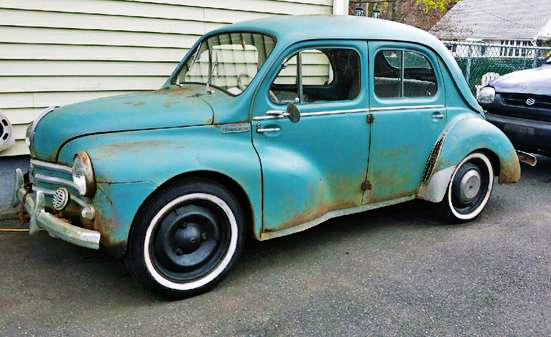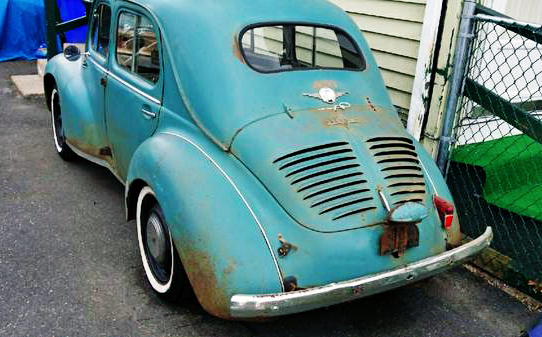For all their issues, quirks, and peculiarities, there is just something about French cars that fascinates us. We love the unusual and simplistic engineering, but we have to admit some of the names they gave their cars were less than interesting. One would think the French would have some of the most creative and profound model names for their cars, but that wasn’t always the case. Now don’t get us wrong some of their cars were given great names, but the ones that went on to be huge successes got titles that were more designations than names. We hadn’t really given much thought to some of these names until we looked at this 1960 Renault 4CV that Harley505 found here on craigslist, which the seller happened to get wrong calling it a C4V. We were actually a bit confused when we searched for it and realized it was supposed to be 4CV, which happens to be very similar to one of the most prolific French cars ever built the Citroen 2CV. This got us wondering how it happened that Renault and Citroen both offered cars in the late 1940’s with similarly bland names. Like usual, the answer turned out to be a rather simple one. Find out what it is right after the break.
The Second World War left the world a very different place. Nations that had once been wealthy were left in ruins. Many nations had sent all their spare resources to help in the war effort, making resources scarce. France had been hit especially hard and what resources were left were needed to rebuild the country. Rather than having large quantities of iron and steel going to car production, the government instituted a system that encouraged car manufactures to build smaller and cheaper cars. The system charged tax based on the horsepower output, with low powered cars being highly favored. For those of us here in the states, this tax is similar to the gas guzzlers tax, except it applies to every car. The CV in both the Renault and the Citroen names mean chevaux, which roughly translates into horsepower. This means the 2CV fell in the 2 horsepower tax bracket and the 4CV landed in the 4 horsepower group. Now the 2 and 4 designation doesn’t mean that these cars only produced 2 or 4 horsepower. To calculate what tax bracket a car was placed in a formula was used looked at displacement, horsepower and several other factors to calculate how much a car should be taxed. This Renault was powered by a 750 cc straight-four mounted in the rear and by 1960 power was up to over 20 hp. The additional 2 cylinders and added power placed the Renault in the higher tax bracket.
Even with bland names like 2CV and 4CV, both cars went on to be very successful both in France and abroad. The Renault was the first French production car to sell over 1 million units and of course Citroen went on to build millions of 2CVs. This 4CV has some issues and will need work, but it looks to be a great starting point. There weren’t many of these imported to the states, but given how many were built and sold worldwide finding parts shouldn’t be all that difficult. After investing the time and money, one should have one of the funniest and most enjoyable micro cars that has ever been built. We think the extra tax was worth every penny, both in the looks and handling departments.





Back in the early 70s, a kid at my high school drove a 4CV the same color as today’s feature and it was not a well liked car and it made him the subject of ridicule. There were no other 4CVs around at the time that I can remember, the only other Renaults were old Dauphines from the late 50s and all were sitting in various people’s yards (and had been for years) I can think of three in my neighborhood. The one closest to us, owners were friends of ours and they offered their non-running Dauphine to me for free. I was 14 at the time, and my Dad said I couldn’t have it. As you would expect, I was kinda steamed at him at the time, but he really did me a favor by not letting me bring it home.
Yeah, yeah, yeah. the same old Renault BS stories. And have you heard the one about the “Prince of Darkness” with Lucas electrics on British cars?
Actually, the 4CV came out before the Dauphine and both were pretty popular where I lived, but I never saw any “for free” ones on front lawns.
Josh, you’re right, there is something fascinating about French cars. This 4CV seems to be all there, although the seller’s shout about “SOLID BODY !!!!” seems a bit inaccurate given the visible rust on the lower extremities. Unfortunately, this is not exactly a fun drive and is probably not quite cute enough to surf on the current micro car wave, so the cost of making it just an attractive driver might not justify the time and/or $$ required.
Flashing back to early 1971 and took a ride to school with a friend in a 4cv. Rowing through the gears changed my life. Bought a quirky R12 tl brand new in 1975 and never looked back. Have owned countless european small displacement autos since and still love the looks, feel and handling. Great memories. I restore as many as time and pocketbook allow and encourage all to do it too. It’s not all about profit, live the history and enjoy each oddball car for what it is. Seems like everyone is involved in this hobby for the wrong reasons these days. IMHO.
What got my attention here was the suiside front doors, how unique and then I thought I’d share with you all! Thanks for the history lesson, just when you think you’ve seen them all out pops another “What the heck” moment! How do you say Beep Beep in French? HOPE YOU ENJOYED!
Mike L.
Beep beep should sound in french Bip Bip… ;-)
Nice to learn about the engine size regulation.
Other explanation about the small size of the european cars is also the size of theirs streets. (friend of mine visited Spain few years ago and told me that every car in the streets have at least one broken side mirror…) Notice also that all, or most of them, trucks are flat nose to permit truck going corners with less problems.
Sorry…..MikeL AKA Harley505!
not sure about this or the dauphine, but the R8/10 sure interest me. might be some interesting renaults at this weekends imports at Carlisle. nice find
I owned one of these back in about 1960. Bought it off a VW used car lot because I couldn’t afford a Beetle. It was really bare bones. With a good tail wind I could hit 60. Had a constant problem of overheating which I never solved.
haven’t seen one of these in years, great looking renault.
Learn something new every day. I would have suspected the CV stood for Crap Vehicle in the Renaults (based on my Renault experience). But then again, honesty never seems to be the best way to sell cars, does it?
Congratulations for the explanation about the french “tax power” or CV. It is perfectly accurate.
The guy next door to my grandparents had a dauphine… traded it in on a Pinto.
We still have a 4CV which our dad kept since the 60s. It is one of about 260 4CV R1063 race cars build. Only around 3 cars are left. But this little thing goes around a 100mph – it´s just more than fun.
Sounds like a Gordini, worth a small fortune if it is! Each to his own I say, we all have different tastes. Frankly the cars which interest me do so because of the design and the philosophy behind it. A car being fast or luxurious in itself is boring, that said, whilst I like the looks of the 4CV and many other small French cars, they really are glacially slow!
Zero to 60 in the same day. I joke of course, I love my Caravelle.
On my walks around the city where I live (Tokyo), one of the more interesting cars I’ve come across is a locally-made version of the 4cv with Hino badging. I wonder how many of those are left!